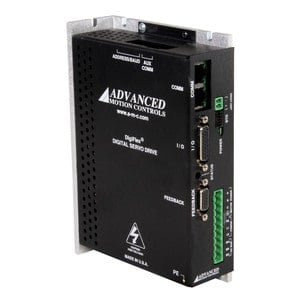What’s the Difference Between a Servo Drive and a Servo Amplifier? A lot of motion control terminology is used interchangeably, situationally, and sometimes incorrectly. We'll be the first to admit that it can be a bit confusing at times, and understandably so. Some of the motion control lingo has changed over time, and it hasn't changed the same way in every region. Linguistic preferences can also change depending on the industry of the application.
This blog should hopefully clear up some of the ambiguities surrounding the motion control terminology of drives, controllers, motors, and more. Again, certain terms may mean different things to different people, but this should serve as a general guide to what's what.
Servo Drive or Servo Amplifier?
Perhaps the most notable of these ambiguous terms are servo drives and servo amplifiers. In truth, it's just like soda, coke, and pop; they mean the same thing in most cases. Servo amplifier, drive, and even driver can be used more or less interchangeably, at least in the United States.
So while servo drive or servo driver sometimes implies a more sophisticated device than a simple servo amplifier, they are the same technology and can be used completely interchangeably in the United States. However, in parts of Europe, people in some industries will say drive or driver in reference motor itself, not the amplifier. In this case, saying servo amplifier (or even controller) can be preferable to avoid confusion. In most cases though, you can call it a servo drive, servo amplifier, or a servo driver and no one will give you grief.
Are Servo Drives only for Servo Motors?
First, the technology all evolved from servo control, and sometimes names just stick. On emails, the Cc line stands for "Carbon Copy," which comes from the old method of creating multiple copies of written or typed documents using carbon paper. While carbon paper is obviously not used for emails, the term still sticks because that's what it is based on. It all started with servos, so we're keeping it.
However, there will always be exceptions (and sticklers who strongly enforce them). Some electronics are particularly designed for another type of motor, such as stepper drives (or stepper amplifiers, stepper drivers, etc.), so servo drive would technically be a misnomer in that case, but still acceptable for most. Others might argue that it's improper to call a drive a servo drive if it is operating a non-servo motor. For this reason, terms like motor drive, motor amplifier, and motor driver can be used as a catch-all term.
ADVANCED Motion Controls digital servo drives from our FlexPro™ and DigiFlex® Performance™ drive families can easily be configured to control linear motors, AC induction motors, two and three-phase stepper motors, voice coils, and more! We call them servo drives, and we're sticking to it.
Are Servo Drives Motor Controllers?
Let's once again go back in time to the early days of servo amplifiers. Motors did indeed run from the power it received from the amplifier. And the amplifier did provide the triple phasing coordination for brushless motors, which was critical for the motor do actually run correctly. First and foremost, however, amplifiers did one thing: amplify. They took in a command signal from an external source such as a dial, slide switch, or computer and powered the motor based on that. If you wanted to change the motor's torque, velocity, or position, you had to change the command signal. The controller is what delivered that command signal.
Now that servo drives have become more advanced, however, the line between drive and controller can be a little blurry. Some analog drives have potentiometers built into them, so if someone was to control a motor by manually adjusting the gain or offset potentiometers (as we sometimes do when performing tests at AMC), then the drive would technically be acting as the controller. That said, these processes are usually done during the tuning process, not used as a control input for the actual application.
When speaking purely in layman's terms, it's very easy to say we make and sell motor controllers at AMC. After all, servo drives are a critical component of motion control, and a drive can act as a controller in many cases. But despite having some overlap, servo drives and motor controllers are not absolute synonyms.
Final Thoughts
As we've discussed, motion control terminology can vary by region, industry, and time period, but hopefully this blog resolves some of the confusion.
If there is anything you are still confused about, feel free to ask us! We know that everyone isn't a motion control expert, and that's okay. With over three decades of experience in the industry, we're happy to lend our knowledge. You can also learn more about motion control terminology and technologies in our Glossary, Motion Control Overview, and Technologies Experience page!
by Jackson McKay, Marketing Engineer
Do you like this article?
Get blogs like this delivered directly to your inbox!
















